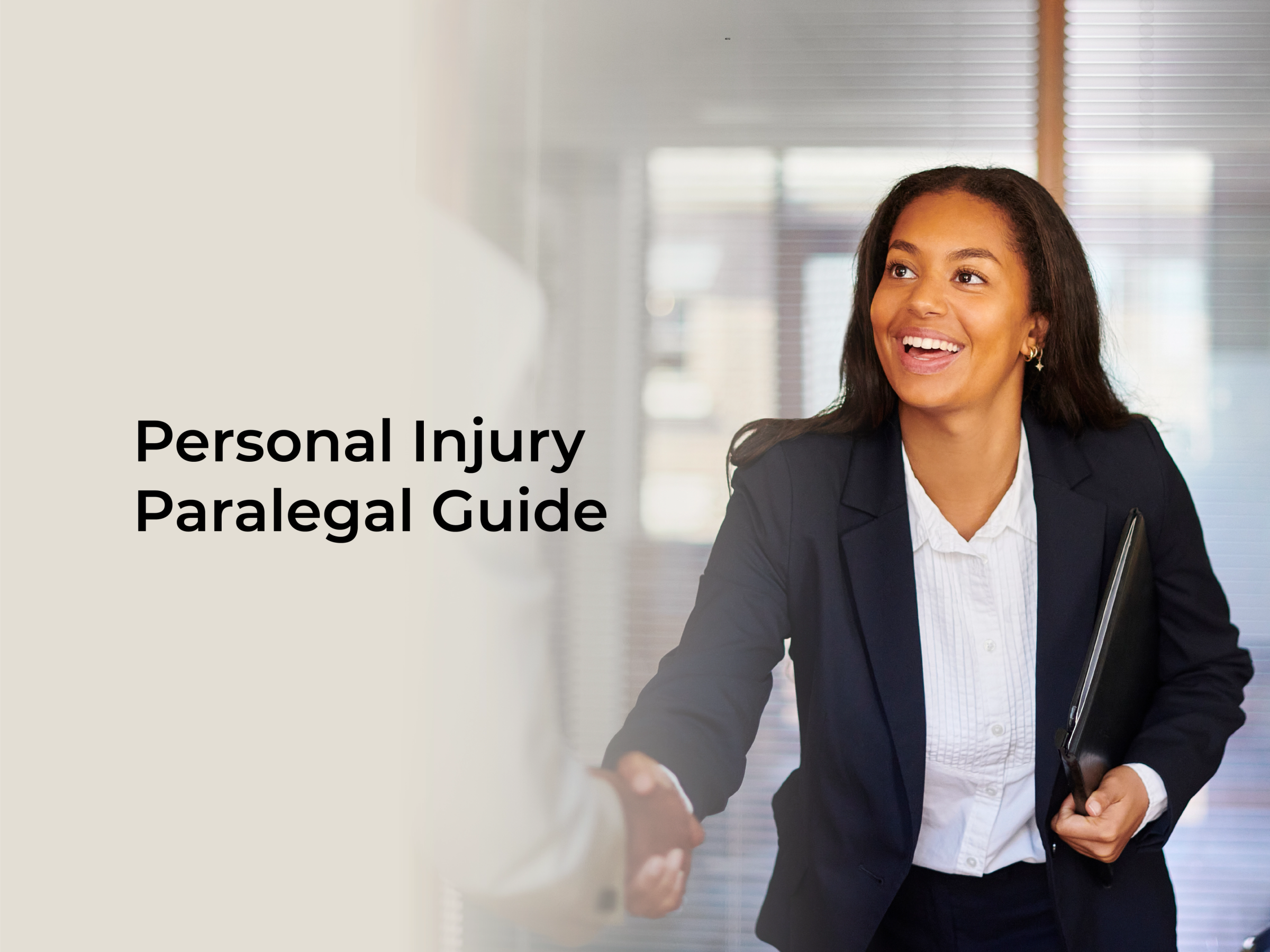Juggling intake forms, medical records, deadlines, and attorney requests is the daily reality of personal injury paralegals. Even the most seasoned paralegal can feel overwhelmed without a clear system. That’s why having a reliable personal injury paralegal guide is essential.
This article provides actionable checklists, workflow strategies, and technology tips for paralegals working on personal injury cases. Along the way, we’ll share how 8am CasePeer, a solution designed specifically for the needs of personal injury practices, is here to help paralegals navigate every step of the way—from intake through settlement.
What does a personal injury paralegal do?
Personal injury paralegals are the backbone of law firms, managing everything from intake to post-settlement. They are often the first point of contact for clients and the steady hand keeps a case on track. Their responsibilities include:
Gathering and organizing client information
Tracking medical treatment and records
Preparing documents for attorneys
Managing case calendars and deadlines
Supporting attorneys through pre-litigation and litigation
Coordinating communication with medical providers, insurance companies, and expert witnesses
Monitoring statutes of limitations and ensuring critical deadlines are met
These tasks require precision, organization, and a deep understanding of personal injury workflows. In short, personal injury paralegals keep cases moving forward, ease the burden on attorneys, and ensure clients feel supported throughout the legal process.
Why checklists are helpful for personal injury paralegals
Checklists improve task clarity, reduce missed deadlines, and keep communication consistent across the team. They also save time by reducing the mental load of remembering repetitive steps, empowering paralegals to focus on higher-value tasks. For personal injury firms, a personal injury paralegal case management checklist ensures that every critical task is handled, from medical record requests to settlement documents.
Benefits include:
Stronger compliance and fewer errors
Improved communication between paralegals and attorneys
Greater consistency and standardization across cases, leading to better outcomes
More efficient time management, keeping cases on track despite heavy caseloads
CasePeer acts as a trusted partner by helping paralegals implement these checklists into their workflows. With built-in calendaring and task automation, paralegals can have peace of mind knowing deadlines won’t be missed and no detail will slip through the cracks. The secure client portal and communication tools in CasePeer make it easy to keep clients informed without relying on unsecured emails.
Personal injury paralegal case management checklist
This core checklist breaks down essential paralegal tasks across each case stage. It aligns with a structured, organized workflow that ensures nothing falls through the cracks.
Intake and initial case setup
Gather client details, accident information, and medical history. Intake forms should also capture witness contacts, insurance data, and preliminary facts.
Secure signed fee agreements, HIPAA forms, and other necessary authorization documents.
Conduct an early viability assessment to decide whether the file should move forward.
Calendaring and statutes
Log statutes of limitations, treatment milestones, and follow-up deadlines.
Schedule key events like depositions, hearings, and expert evaluations.
Use the CasePeer event calculator and automated calendaring to sync deadlines across your external calendar (Outlook, Google, iCal) and send reminders proactively.
Investigation and evidence
Record witness statements and collect photos, police reports, and insurance documents.
Track and log damage assessments, bills, medical records, and treatment history.
Maintain comprehensive investigation notes in one place for quick reference.
Legal document prep
Draft demand letters, complaints, discovery requests/responses, and settlement documents. Include medical summaries, injury narratives, and damage estimates.
Use standardized templates for consistency and efficiency.
Court and post-resolution
Support attorneys in trial preparation, including motions, trial binders, exhibits, and court filings.
Track deadlines for pretrial motions, status conferences, and hearings.
Post-resolution: finalize settlement paperwork, manage lien disbursement, ensure correct fund allocation, and close the client file.
Key skills every PI paralegal should master
Paralegals need more than basic administrative work to succeed in personal injury. These abilities directly impact the success of cases and the efficiency of the law firm:
Fluency in medical records and injury terminology: Paralegals must understand how to read, interpret, and organize medical documentation, which is often central to proving damages in personal injury cases.
Proactive deadline and calendar management: Staying ahead of statutes, treatment milestones, and filing deadlines is essential to prevent costly oversights and ensure cases move forward smoothly.
Strong document organization systems: Personal injury cases involve hundreds of records and files. A structured system for storing, retrieving, and updating documents keeps attorneys prepared and cases audit-ready.
Developing workflow templates: Building templates for recurring tasks, like demand letters or intake forms, saves time and ensures consistency across every case.
Tracking expert witnesses and providers: Maintaining accurate records of expert availability, testimony history, and medical providers helps strengthen case strategy and preparation.
Understanding litigation handoff processes: A smooth transition from pre-litigation to litigation prevents delays, ensures all documents are ready for court, and maintains momentum.
Comfort with technology like CasePeer and AI-powered tools: Modern paralegals must embrace personal injury technology to manage deadlines, automate tasks, and gain insights, which will give them an edge in high-volume practices.
To continue developing your expertise, consider enrolling in personal injury–focused paralegal courses that deepen your understanding of medical records, case workflows, and litigation processes.
Common bottlenecks with paralegal workflows
Personal injury paralegals manage a constant flow of documents, deadlines, medical updates, and client interactions. With so many moving pieces, even small inefficiencies can create major setbacks. Below are some of the most common bottlenecks that personal injury paralegals encounter—and how proactive strategies and technology can help address them.
Limited technology adoption
Many personal injury firms still rely on spreadsheets, shared drives, or even paper files to manage complex cases. While these systems may work for smaller caseloads, they create risks as volume increases—missed deadlines, misplaced records, and inconsistent processes. For paralegals, that often means hours spent chasing information instead of moving cases forward.
Delays in medical records and documentation
Medical records are the foundation of most personal injury cases, yet requests to providers are often delayed, incomplete, or misplaced. These delays can stall case progress for weeks or even months. Paralegals must be proactive in following up with providers, tracking requests in a centralized system, and documenting every interaction.
Missed deadlines and calendar gaps
With statutes of limitation, treatment milestones, deposition dates, and court filings all requiring close monitoring, a missed deadline can seriously jeopardize a case. Manual tracking systems leave room for error, especially in high-volume practices. Automated calendaring in CasePeer helps eliminate these risks by creating alerts, syncing calendars, and ensuring no important date is overlooked.
Lack of workflow standardization
When every paralegal approaches tasks differently, firms risk inconsistency, duplicated efforts, and lost efficiency. Without a standard process, valuable time is wasted reinventing workflows for each new case. Standardized checklists and workflow tools create consistency, reduce errors, and improve collaboration across the team.
Implementing paralegal checklists in case management workflows
Using checklists ensures that paralegal workflows are consistent, efficient, and defensible across large caseloads. They reduce errors, create accountability, and streamline communication when multiple team members work on the same file. A checklist-driven process helps paralegals stay organized and ensures that attorneys and clients receive timely updates.
To put checklists into action, firms should:
Identify the core stages of a personal injury case (such as intake, medical records, demands, litigation, and settlement).
Create checklists that clearly outline tasks within each step.
Assign responsibilities so paralegals know exactly what they own and when it must be completed.
Incorporate these checklists into daily routines to build consistency across the firm.
Digital checklist vs. case management software
Digital checklists: Keeping a checklist in Word, Excel, or Google Sheets can be a good starting point, especially for smaller firms or new paralegals. They provide structure, but they lack automation, integration, and real-time accountability.
Case management software: Platforms like CasePeer take checklists and task management to the next level with automation, task assignments, due date tracking, and template integration. All case data and documents are centralized, reducing errors and eliminating the need to manage multiple tools.
A workflow checklist template for paralegal case management is useful, but scaling efficiency and ensuring accountability often require software built specifically for law firms. CasePeer is not a replacement for checklists—it’s the smarter way to implement, manage, and improve them across the entire case lifecycle.
Why modern paralegals are using CasePeer
CasePeer is designed specifically for personal injury firms, making it the go-to tool for paralegals. Features include:
Task and deadline automation
Medical record tracking
Document management and templates
Client communication tools
Modern paralegals rely on CasePeer to reduce stress, stay organized, and deliver better outcomes. Ready to simplify your workload? Book a CasePeer demo today.
About the author

M.E. HammondSenior Content StrategistAffiniPay
